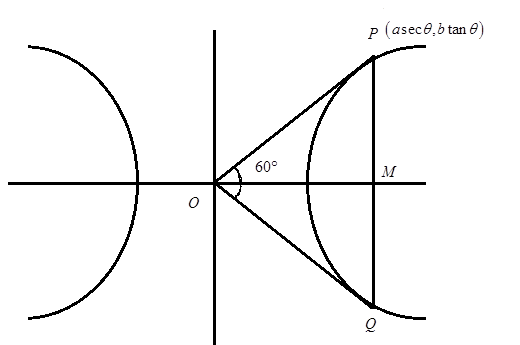
If PQ is a double ordinate of the hyperbola
A.
B.
C.
D.
Answer
529.8k+ views
1 likes
- Hint: We will be using the concept of hyperbola to solve the problem. We will first use the parametric form of a point on hyperbola to find a general point on hyperbola then we will use the given condition that the triangle is equilateral to find a relation between a and b and then we will be using the concept of eccentricity double ordinate to further simplify the problem.
Complete step-by-step solution -
We have been given a hyperbola

Now, we have been given that
Now, since PQ is a double ordinate therefore the
Now, we take the coordinate of P in parametric form as
Therefore, the slope OP is,
From the formula
Also, the slope is equal to tan 30 as we have been shown above. Therefore,
Now, we will use the identities,
Now, we will square both sides to simplify it,
Now, we know that the eccentricity of hyperbola is given by,
We will substitute the value of
Now, we know that the range of
So, the range of
Now, we will use this in (2), where
We will ignore the negative inequality since e > 1 for hyperbola. Therefore,
Hence, option (D) is correct.
Note: To solve these types of questions one must have a basic understanding of the concepts of hyperbola like double ordinate also it is important to note how we have used the condition of equilateral triangle to solve the problem.
Complete step-by-step solution -
We have been given a hyperbola

Now, we have been given that
Now, since PQ is a double ordinate therefore the
Now, we take the coordinate of P in parametric form as
Therefore, the slope OP is,
From the formula
Also, the slope is equal to tan 30 as we have been shown above. Therefore,
Now, we will use the identities,
Now, we will square both sides to simplify it,
Now, we know that the eccentricity of hyperbola is given by,
We will substitute the value of
Now, we know that the range of
So, the range of
Now, we will use this in (2), where
We will ignore the negative inequality since e > 1 for hyperbola. Therefore,
Hence, option (D) is correct.
Note: To solve these types of questions one must have a basic understanding of the concepts of hyperbola like double ordinate also it is important to note how we have used the condition of equilateral triangle to solve the problem.
Latest Vedantu courses for you
Grade 9 | CBSE | SCHOOL | English
Vedantu 9 CBSE Pro Course - (2025-26)
School Full course for CBSE students
₹37,300 per year
Recently Updated Pages
Master Class 11 Business Studies: Engaging Questions & Answers for Success

Master Class 11 Economics: Engaging Questions & Answers for Success

Master Class 11 Accountancy: Engaging Questions & Answers for Success

Master Class 11 Computer Science: Engaging Questions & Answers for Success

Master Class 11 Maths: Engaging Questions & Answers for Success

Master Class 11 English: Engaging Questions & Answers for Success

Trending doubts
Which one is a true fish A Jellyfish B Starfish C Dogfish class 11 biology CBSE

Difference Between Prokaryotic Cells and Eukaryotic Cells

1 ton equals to A 100 kg B 1000 kg C 10 kg D 10000 class 11 physics CBSE

One Metric ton is equal to kg A 10000 B 1000 C 100 class 11 physics CBSE

1 Quintal is equal to a 110 kg b 10 kg c 100kg d 1000 class 11 physics CBSE

Net gain of ATP in glycolysis a 6 b 2 c 4 d 8 class 11 biology CBSE




